|
Author
|
Topic: Ares/Orion lightning protection system
|
Robert Pearlman
Editor Posts: 50516
From: Houston, TX
Registered: Nov 1999
|
 posted 07-27-2007 07:23 PM
posted 07-27-2007 07:23 PM
   
NASA release
NASA Selects Lightning Protection System Contractor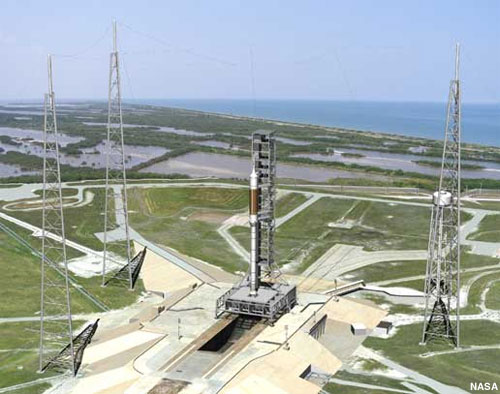
NASA has selected Ivey's Construction Inc. of Merritt Island, Fla., to build a new lightning protection system for Launch Pad 39B at the Kennedy Space Center. The system will support launches of the Constellation Program's Ares I rockets.The lightning protection system is designed to reduce the probability of a direct lightning strike to the Ares I and associated launch equipment during processing and other activities prior to flight. Under the contract, the company will provide all labor and materials to fabricate and construct three 600-foot, self-supporting structural steel towers and an overhead wire system with associated conductors. Ivey's Construction Inc. will receive a fixed-price contract for $27,915,000. The system is expected to be complete by March 2010. Click here for an animation of the lightning protection system in action. |
KSCartist
Member Posts: 3047
From: Titusville, FL
Registered: Feb 2005
|
 posted 07-30-2007 07:02 AM
posted 07-30-2007 07:02 AM
   
I know Jeff Ivey. In fact his two sons were members of the Young Astronaut Club at their school when I was there. NASA couldn't have picked a finer bunch of folks to get this job done. Tim |
Robert Pearlman
Editor Posts: 50516
From: Houston, TX
Registered: Nov 1999
|
 posted 06-04-2008 10:53 AM
posted 06-04-2008 10:53 AM
   
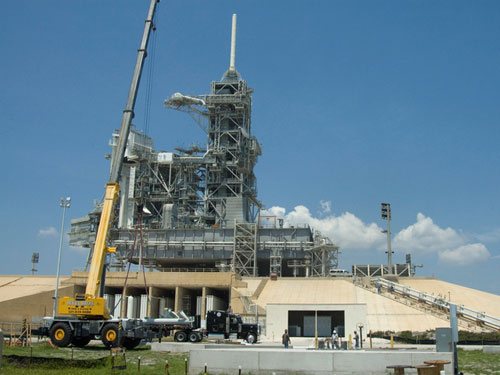 On Pad 39B at NASA's Kennedy Space Center, a crane is removing parts of the lightning mast to be erected on towers being built for the Constellation Program and Ares/Orion launches. Behind it are the fixed and rotating service structures on top of the pad. An 80-foot lightning mast is on top of the fixed service structure as part of the former lightning protection system. Pad B will be the site of the first Ares vehicle launch, including Ares I-X which is scheduled for April 2009. 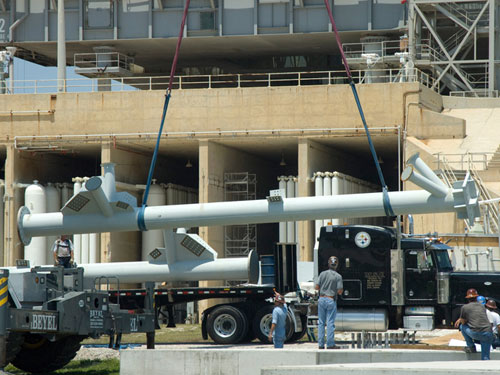 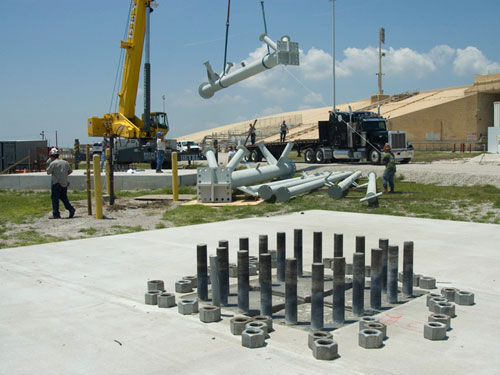
In the foreground is the base of one of the towers to be built. |
Robert Pearlman
Editor Posts: 50516
From: Houston, TX
Registered: Nov 1999
|
 posted 06-04-2008 03:56 PM
posted 06-04-2008 03:56 PM
   
NASA feature Lightning Protection for the Next Generation SpacecraftThunder rumbles in the distance as darkening clouds gather above NASA Kennedy Space Center's Launch Pad 39B, where a sleek Ares I launch vehicle stands awaiting an upcoming flight. A blinding lightning flash suddenly streaks down from the sky, striking one of the pad's tall steel masts. The surge of electrical current quickly is diverted away from the rocket and carried safely into the ground. This scenario hasn't happened yet; the Ares I rocket is still in development, and NASA is just beginning to transition Launch Pad 39B from a space shuttle facility into the launch site for the Constellation Program's Ares I crew launcher. But lightning is a well-known danger in central Florida, and a team of NASA and contractor personnel already is working to design and build a new lightning protection system that's larger than any the spaceport has ever seen. The new system features large cables strung between three 594-foot-tall steel and fiberglass towers. Called a catenary wire system, it will dominate the launch area's skyline. The new system will provide better protection from lightning strikes and help avoid delays to the launch schedule by collecting more information on the strike for analysis by launch managers. Launch Pads 40 and 41, located south of Launch Complex 39, each have lightning protection systems similar to the new version. Each tower is topped with a fiberglass mast and a series of catenary wires and down conductors designed to divert lightning away from the rocket and service structure. This configuration helps keep the vehicle isolated from dangerous currents. Lightning protection systems have steadily evolved as the space program has progressed. The Apollo system, for example, was a bonded system. "A bonded structure is part of the launch structure," says Constellation Senior Pad Project Manager Jose Perez Morales. "Obviously, if you get a lightning strike, it doesn't matter how well you place your wires -- you're going to get current going through the structure." For the space shuttle, the lightning protection system consists of a lightning mast on the top of each pad's service structure and two catenary wires. This system provides shielding to the space shuttle and diverts strike currents down to the ground, making it an isolated system and an improvement over the Apollo arrangement. The system under development for the Constellation Program’s next-generation vehicles would significantly increase the shielding level and further separate the electrical current from vital launch hardware. Additionally, technology has advanced considerably since the early days of space exploration. Lightning detection has become simpler and faster as computer modeling has become more sophisticated. "In the years of Apollo, most of these things were done by hand," Perez notes. "Because of the new computers and the ability to do a lot of probability models, the whole thing has evolved. That's how they can now design more effective lightning protection systems." Now there are decades' worth of local lightning data recorded, so computer models are not only faster, but more accurate than ever. There's another benefit to the new system: An array of sensors, both on the ground and the mobile launcher, will help determine the vehicle's condition after a nearby lightning strike. This can prevent days of delays. Currently, "If there's been a strike and you're not sure whether the vehicle was hit, then at the very least you could have an impact on your schedule because you'll have to stop and test," says NASA Project Manager Lori Jones. Ivey's Construction Inc., the contractor in charge of building the lightning protection system, received NASA's go-ahead to proceed in September. Construction began in November with the arrival of large cranes and concrete pilings. The system's foundation will include 216 of these pilings extending up to 55 feet below ground. The massive steel towers will be partially assembled horizontally on the ground, then lifted into the vertical position by a 60-story-tall crane. Construction is expected to be complete in 2010. According to NASA Construction Manager Jason Ritter, along with the standard challenges associated with this construction effort, nature will provide a few of its own. "Most of the work isn't technically difficult, but it's big and time-consuming," Ritter says. "When you're working on a launch pad that has lightning and high winds and sea breezes, and it's an operational pad, those are the things we consider difficult to work through." |
Robert Pearlman
Editor Posts: 50516
From: Houston, TX
Registered: Nov 1999
|
 posted 07-07-2008 11:15 AM
posted 07-07-2008 11:15 AM
   
Update as of June 30, 2008: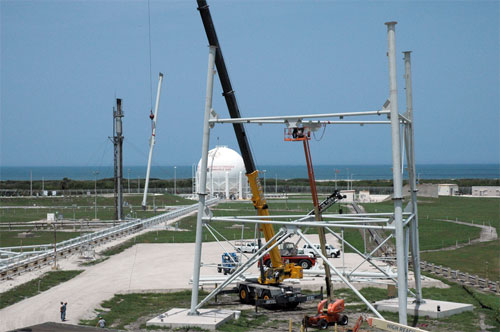
With the backdrop of a blue sky and the blue Atlantic Ocean, workers are constructing the lightning towers on Launch Pad 39B at NASA's Kennedy Space Center. In the background, at left, is the liquid hydrogen tank that helps fuel a space shuttle for launch. |
music_space
Member Posts: 1193
From: Canada
Registered: Jul 2001
|
 posted 07-10-2008 05:04 PM
posted 07-10-2008 05:04 PM
   
Seeing the video, it seems that the spacecraft has to not only "clear the tower" but further, to pass through the pentagon formed by the inner system of wire conductors.Will Houston MOCR take control after those cables are cleared, rather than after the tower per say is cleared? ------------------
François Guay
Collector of litterature, notebooks, equipment and memories! |
Robert Pearlman
Editor Posts: 50516
From: Houston, TX
Registered: Nov 1999
|
 posted 08-31-2008 09:37 AM
posted 08-31-2008 09:37 AM
   
Photo update as of August 1, 2008: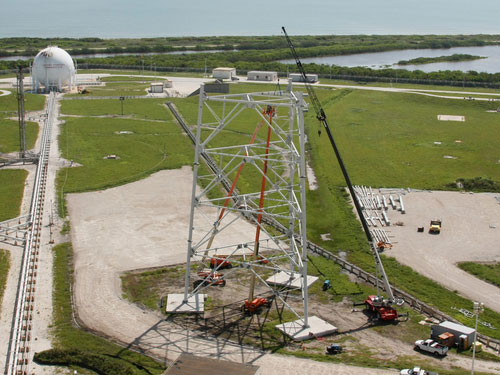
|
Robert Pearlman
Editor Posts: 50516
From: Houston, TX
Registered: Nov 1999
|
 posted 01-05-2009 11:40 AM
posted 01-05-2009 11:40 AM
   
It seems that the workers erecting the Ares lightning protection towers made good use of the holiday break. This photo was taken on December 22, 2008: 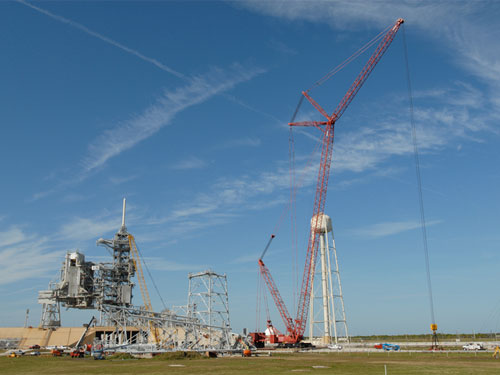
Today, a NASA webcam pointed at Pad 39B appears to show that one of the towers has been completed: 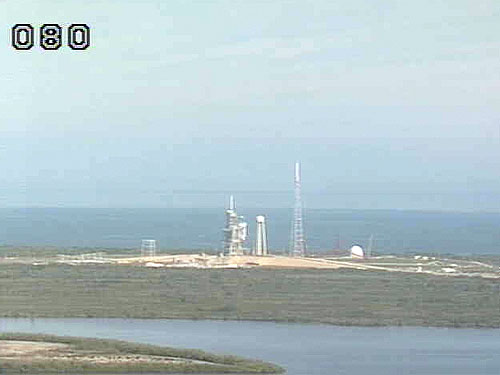
|
Robert Pearlman
Editor Posts: 50516
From: Houston, TX
Registered: Nov 1999
|
 posted 01-05-2009 08:08 PM
posted 01-05-2009 08:08 PM
   
NASA photographs showing a crane placing the 100-foot fiberglass mast atop the new lightning tower constructed at Pad 39B.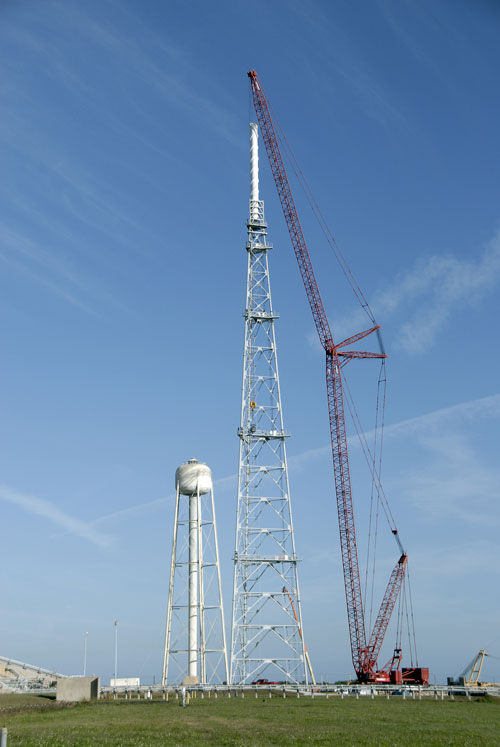
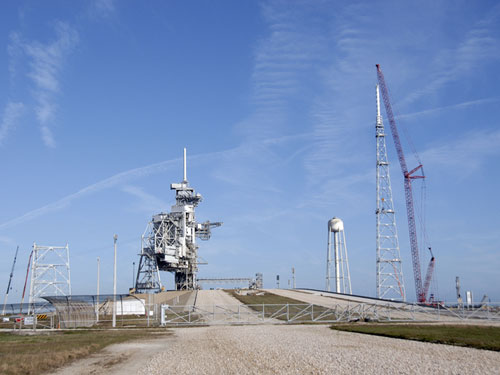
|
Robert Pearlman
Editor Posts: 50516
From: Houston, TX
Registered: Nov 1999
|
 posted 02-12-2009 09:09 PM
posted 02-12-2009 09:09 PM
   
NASA photographs taken on February 12. show erection of the three lightning towers is nearing completion as only a mast remains to be added to the third.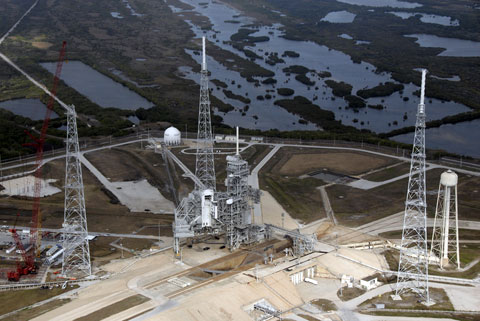 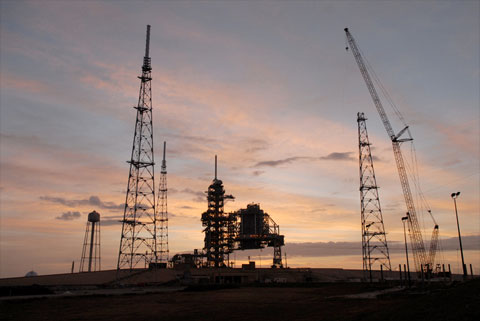
|
Robert Pearlman
Editor Posts: 50516
From: Houston, TX
Registered: Nov 1999
|
 posted 02-18-2009 09:59 AM
posted 02-18-2009 09:59 AM
   
The three towers at Pad 39B are complete, as shown in this photograph by Ben Cooper (LaunchPhotography.com).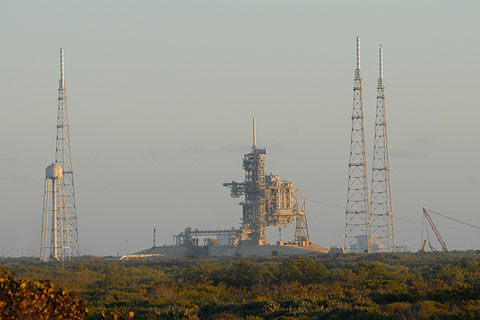 
|
garymilgrom
Member Posts: 2125
From: Atlanta, GA
Registered: Feb 2007
|
 posted 02-18-2009 10:40 AM
posted 02-18-2009 10:40 AM
   
Has the catenary been hung from the towers yet? |
Robert Pearlman
Editor Posts: 50516
From: Houston, TX
Registered: Nov 1999
|
 posted 02-18-2009 10:54 AM
posted 02-18-2009 10:54 AM
   
The wire system has yet to be strung; the third tower was only completed within the last couple of days. |
tegwilym
Member Posts: 2339
From: Sturgeon Bay, WI
Registered: Jan 2000
|
 posted 02-18-2009 01:14 PM
posted 02-18-2009 01:14 PM
   
That still is an active launch pad?
Just wondering since if the Hubble flight does go (now that the satellite wreckage is making things even uglier) will they still use that as a rescue pad for another shuttle?Tom
|
Robert Pearlman
Editor Posts: 50516
From: Houston, TX
Registered: Nov 1999
|
 posted 02-18-2009 01:19 PM
posted 02-18-2009 01:19 PM
   
Pad 39B can still be used to launch the contingency rescue mission for STS-125 if necessary, though the shuttle program is still discussing the possibility of using a one-pad approach (that being Pad 39A) so as to permit the Constellation program to move forward with more of the modifications to 39B. |
Robert Pearlman
Editor Posts: 50516
From: Houston, TX
Registered: Nov 1999
|
 posted 03-14-2009 07:36 AM
posted 03-14-2009 07:36 AM
   
A few photos from a recent media tour of Pad 39B (click to enlarge).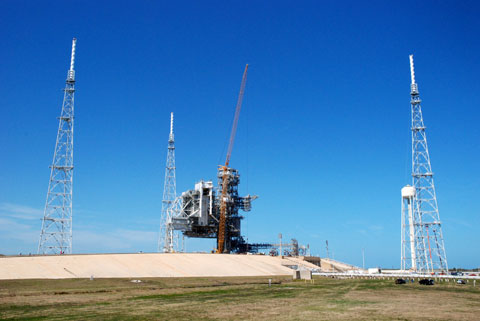 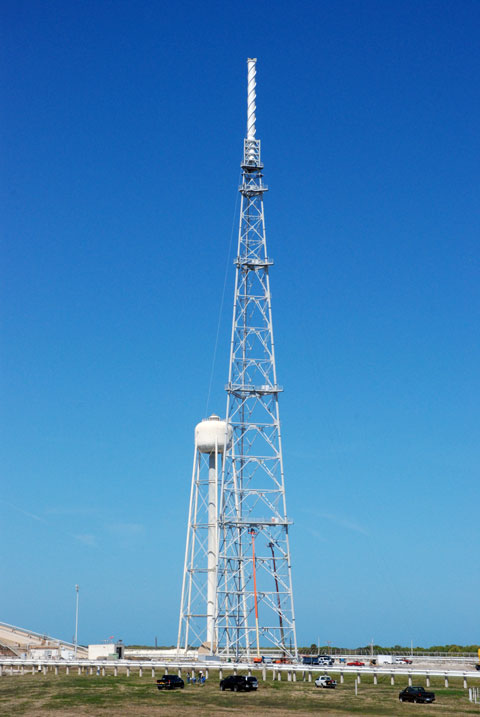
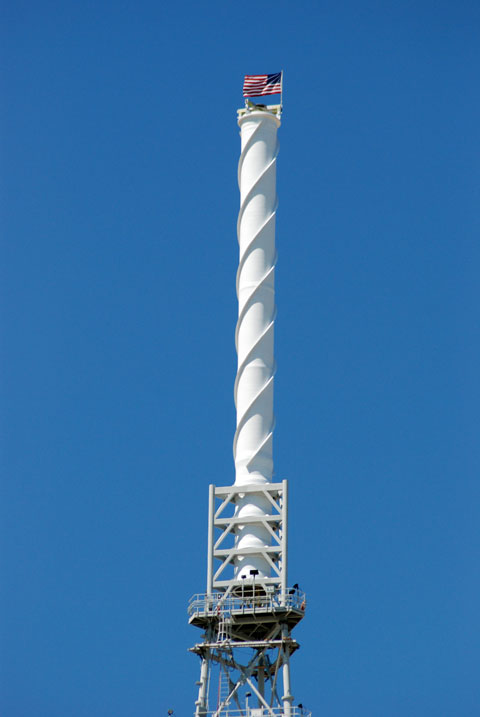
|
Blackarrow
Member Posts: 3604
From: Belfast, United Kingdom
Registered: Feb 2002
|
 posted 03-14-2009 03:14 PM
posted 03-14-2009 03:14 PM
  
How much will these new towers affect the view of the launch from each pad? |
Robert Pearlman
Editor Posts: 50516
From: Houston, TX
Registered: Nov 1999
|
 posted 03-14-2009 03:37 PM
posted 03-14-2009 03:37 PM
   
The towers are far less a visual blockade than are the fixed and rotating service structures, both of which will be removed before Ares I flies (a launch umbilical tower, such as was used during Apollo, will support the vehicle atop the mobile launcher platform).For reference, here is a photograph of both pads taken yesterday from the press site 3.5 miles away (click to enlarge). 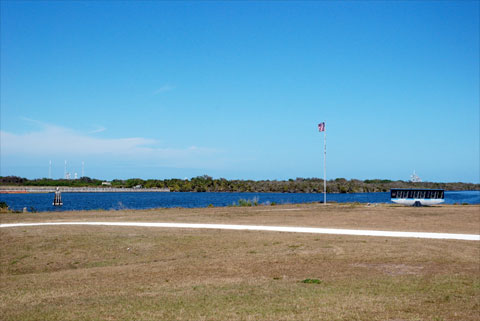 |
Blackarrow
Member Posts: 3604
From: Belfast, United Kingdom
Registered: Feb 2002
|
 posted 03-15-2009 12:53 PM
posted 03-15-2009 12:53 PM
  
Thanks, Robert. I was thinking more of the view from the Causeway, which is probably the best ordinary mortals can aspire to on a launch-day, but it seems clear from your photo that the towers won't be much of a hindrance to the view. |





























